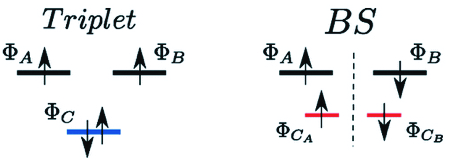In a molecule bearing several unpaired local spins, one of the pertinent parameters that govern its magnetic properties is the magnetic exchange interaction constant
J that describes the way spins “talk to each other” through the atoms connecting them (bridges). The RM laboratory, by revisiting one of the theoretical chemistry methods dedicated to the computation of
J, has identified a major flaw in this approach, the correction of which opens the way to an improvement of the calculation of
J.
When a molecule has several unpaired spins (for example two Cu
2+ ions corresponding each to a local spin ½), these spins can establish a “dialog”, and a scale of magnetic levels appears (in the previous example, a triplet ↑↑ and a singulet ↑↓ – ↓↑ states). The relative energies of these levels are directly related to the magnetic exchange interaction constant
J, the value of which depends on the nature of the spin carriers (metal, radical) as well as on the geometry and chemistry of the diamagnetic bridges that connect them (OH
- ions for instance). From a practical point of view, these interactions are responsible for the magnetic behavior of the molecule: ferro- or antiferromagnetic.

A widespread method for the calculation of
J is based on what is called the “broken symmetry” state (BS, ↑↓). Yet, when compared to experiment, this calculation overestimates
J typically by a factor of 2. In order to identify the source of the problem, an analytical expression of
J was derived by taking into account the physical mechanisms involved in the BS state, and was parameterized by the Density Functional Theory (DFT). We have shown that most of the error came from the BS procedure itself that artificially breaks the symmetry of the bridge orbitals ΦC, which were no longer diamagnetic (a process never reported until now). After correction of this unwanted effect, the
J values become comparable to those obtained by other more sophisticated methods at the same physical level.